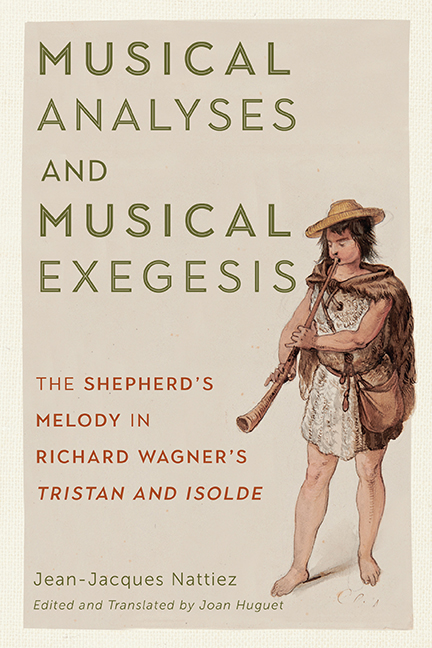 Musical Analyses and Musical Exegesis
Musical Analyses and Musical Exegesis Published online by Cambridge University Press: 02 June 2021
The Shepherd's Melody from the Prelude to the Solo
Beginning and Ending in Tristan
As Michel Imberty reminded us in the previous chapter, the Tristan Prelude is not tonally closed: “The harmonic structure of the Prelude and the principal motives that comprise it are in a state of perceptual incompleteness. Infinite melody, continuing tonal instability, a future without end …” At the conclusion of the Prelude, the return of its opening material (m. 100) first leads to the unresolved 2 B from measure 3 (m. 103), then to the 4 D from measure 7 (m. 106). This partial reprise all occurs over a secondary dominant of C minor that is prolonged from measures 100–111, connecting the Prelude to the beginning of act I, scene 1. Imberty comments: “In this respect, the English horn alte Weise gives us yet another example of infinite melody: it does not want to end.” Indeed, both my linear analyses (chapter 1) and my sketch studies (chapter 8) of the solo demonstrated that it is a model example of infinite melody.
However, there is a problem with Imberty's hypothesis: while the alte Weise perhaps does not ever wish to end, the solo as a unit does end. While we might view it as a neverending quest towards a deferred tonic resolution, this resolution decisively occurs in measure 42. As a result, the English-horn solo, unlike the Prelude, is tonally closed. Imberty correctly states that passages of diatonic harmony are almost completely absent from the Tristan score. However, the solo is an exception: it clearly begins in F minor, and in spite of its many chromatic fluctuations, unambiguously remains and concludes there, as described in all of part I's neutral-level analyses. Linear analysis demonstrated that it resolves every moment of incomplete closure along its path, including the dominant C in measure 21, the G in measures 9, 26–30, and 35; and the G♭ in measures 8–9 and 30–34.
Tristan und Isolde ends with an apotheosis in the affirmative key of B major, recalling the initial motive's resting point in measure 3 of the Prelude. It might be useful to consider the meaning of the opera's conclusion, which Wagner himself referred to as redemptive, from a hermeneutic perspective (see the end of chapter 11).
To save this book to your Kindle, first ensure [email protected] is added to your Approved Personal Document E-mail List under your Personal Document Settings on the Manage Your Content and Devices page of your Amazon account. Then enter the ‘name’ part of your Kindle email address below. Find out more about saving to your Kindle.
Note you can select to save to either the @free.kindle.com or @kindle.com variations. ‘@free.kindle.com’ emails are free but can only be saved to your device when it is connected to wi-fi. ‘@kindle.com’ emails can be delivered even when you are not connected to wi-fi, but note that service fees apply.
Find out more about the Kindle Personal Document Service.
To save content items to your account, please confirm that you agree to abide by our usage policies. If this is the first time you use this feature, you will be asked to authorise Cambridge Core to connect with your account. Find out more about saving content to Dropbox.
To save content items to your account, please confirm that you agree to abide by our usage policies. If this is the first time you use this feature, you will be asked to authorise Cambridge Core to connect with your account. Find out more about saving content to Google Drive.